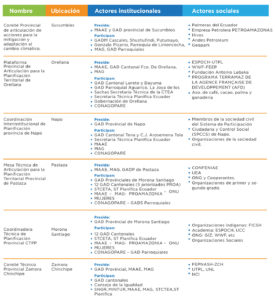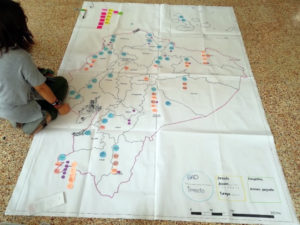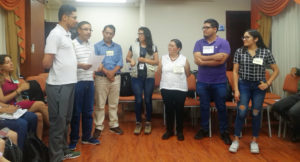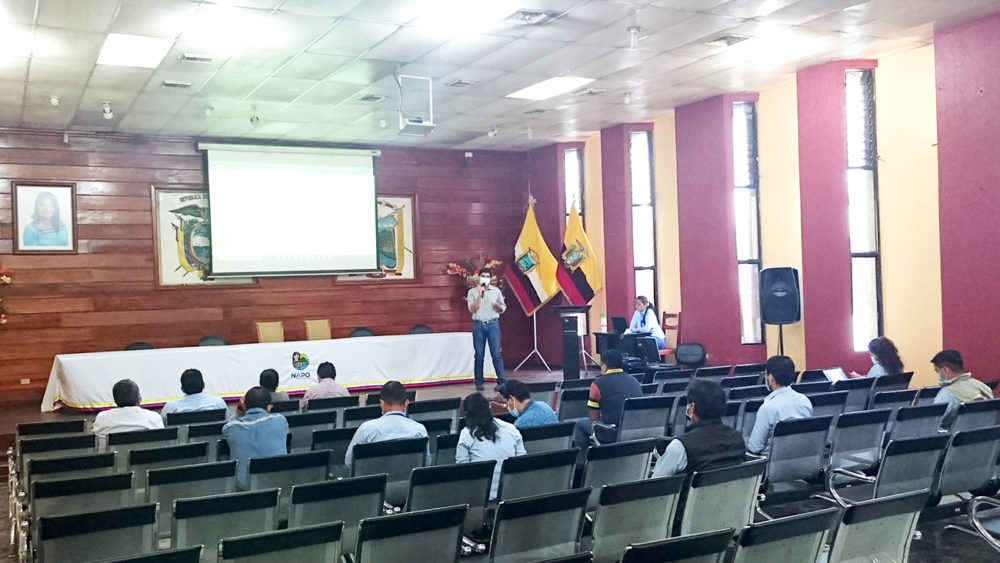(The note contains graphics in Spanish)
The territorial dynamics of the Ecuadorian Amazon Region (RAE) has its peculiarities, due to the same conception of its spaces, as well as its ethnic and landscape diversity. The great wealth offered by each of the six provinces from the approaches of conservation, sustainable production, climate change, gender and interculturality, among others, should be considered as an opportunity to strengthen or create platforms of involvement and interaction of actors that make viable the implementation of the REDD+ AP, aligned under a local, regional and national approach. This, allowing interaction between the different levels of government and the sectors that intervene in each territory so that, in this way, the strengths of the provinces are enhanced and territorial planning is improved.
In each of the provinces that make up the RAE, there are both governmental and private actors, academia, Non-Governmental Organizations (NGOs) and Civil Society Organizations (CSOs), which stimulate the activities and investment made in the different scopes. However, the lack of synergies, complementarity and interaction in activities has meant that the impact of actions and investments have been limited, isolated, dispersed and have not been consolidated in order to reduce deforestation processes due to various causes and improve the quality of life of the Amazonian inhabitants.
This is why the proposal to create or strengthen provincial platforms that articulate and help coordinate initiatives with emphasis on the application of the REDD+ AP is necessary to carry out collective actions from different fronts under the same planning and motivation.
In this sense, the objective of the Ministry of Environment and Water (MAAE) and the Ministry of Agriculture and Livestock (MAG); through PROAmazonía, with the assistance of UNDP, is to support the transformation of Land Use Planning and Management in the Amazon Special Territorial Circumscription (CTEA) through the establishment and strengthening of a Governance and Sustainable Production Framework, based on a landscape approach, and the optimization of ecosystem services and livelihoods, for which the spaces for dialogue and inter-institutional alliances are strengthened through six provincial articulation platforms.
With the aim of institutionalizing provincial platforms, PROAmazonía provides technical assistance, advice, facilitation and the development of instruments and evaluations (e.g., action plans, formulation of proposals for local regulations, preparation of progress reports, among others) that will serve as input for the formulation or adjustment of local sectoral policies and the implementation of territorial planning. This set of interventions will create an enabling environment for an effective governance framework to manage land use conflicts and optimize the sustainable management of land, forests and biodiversity conservation.
Additionally, through PROAmazonía, the participation of women, peoples and nationalities in planning and decision-making processes regarding the development of the territory is encouraged. This, through their participation in the Territorial Articulation Platforms, Citizen Assemblies and Local Planning Councils (40% participation by women and 60% participation by indigenous peoples); in addition to training its members on issues related to the gender and intercultural approach; and, promoting the participation of the Gender Equality Council; which is in charge of national gender policies, in these spaces.
Graph # 1 – Current status of the conformation of the six provincial articulation platforms

Graph # 2 – 2021 Milestones that are managed in the provincial articulation platforms through the interaction and involvement of key actors

*CLP-GAD = The Local Planning Councils of the Decentralized Autonomous Governments (GAD) will participate in the process of formulation, monitoring and evaluation of their plans and will issue a favorable resolution on the strategic development priorities as an essential requirement for their approval before the corresponding legislative body (Art. 300, COOTAD, 2010.)
** The Network of local information managers facilitates decision-making, the formulation of public policies, the development of planning and land use planning proposals; and, the monitoring and evaluation of the Land Use and Development Plans (PDOT), in addition to other planning instruments (Art. 5, subparagraph b, Technical Standard for Local Information Systems, 2018).

Photography: Gustavo Jaramillo, (04-09-2019)
Description: Talking map on actions, synergies and actors identified for the implementation of the
territorial planning

Photography: Gustavo Jaramillo, (11-12-2019)
Description: “Territorial planning workshop with a focus on climate change, conservation and sustainable production,”
Exercise on the role of actors in a provincial inter-institutional articulation space, Puyo-Pastaza.
Author: Gustavo Jaramillo, Technical Expert for the Strengthening of Planning and Territorial Management Processes at the National Level and their relationship with the GADs
 Español
Español English
English

Comments are closed.